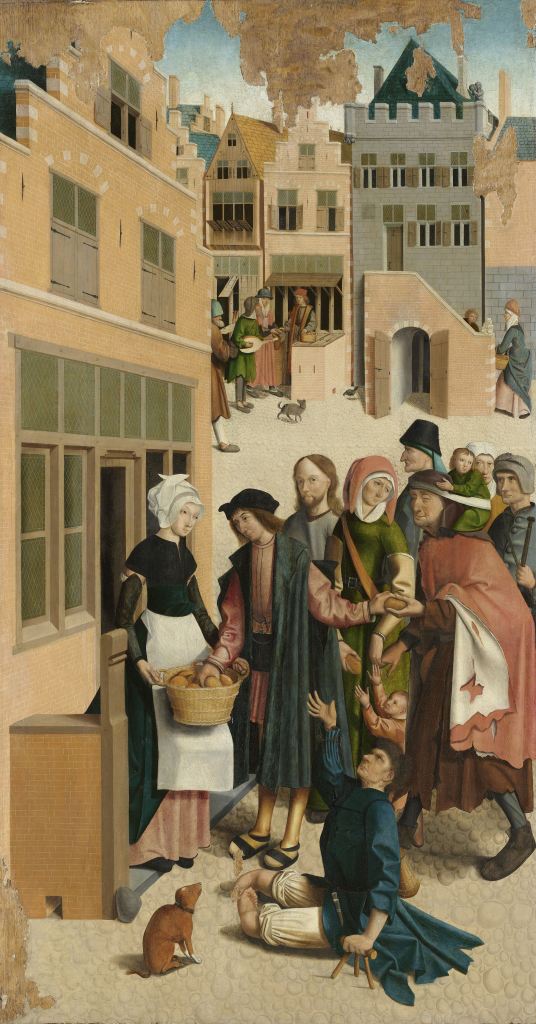For the last seventy years or so people in western Europe have been able to rely on the free market to provide them with a great variety of foodstuffs at affordable prices. Currently, however, food prices in the supermarkets of western European countries are rising dramatically and in some cases customers encountered empty shelves. Households are struggling to make ends meet and a growing number of people depend on food banks for support. Are these just temporary problems, caused by adverse weather, the war in Ukraine and soaring energy prices? Or are there structural causes as well? It is hard to predict what the future will bring, but the cost-of-living crisis has made it clear that European consumers are not immune from the impact of price rises. It has also raised doubts about the capability of the free market to ensure food provisioning in an era of shortages, uncertainty and conflict.
Food entitlements
In pre-industrial Europe people were not inclined to rely on market mechanisms during crisis situations. When food prices rose they expected the authorities to intervene. One type of intervention bears some resemblance to the activities of the present-day food banks. From the late Middle Ages onward European towns, and sometimes villages as well, established stocks of bread grain and later also potatoes to be distributed at affordable prices when the need was there. Significantly, just as today, food crises in the past did not hit everybody equally. In the towns the main victims were the laboring poor, who were dependent on low and irregular wages and could no longer afford to buy food when prices peaked. To put it in the words of economist Amartya Sen: subsidized bread distributions were a way to enhance the ‘food entitlements’ of these people.
As a historian I find these public stocks intriguing. They show the lengths to which communities would go to ward off hunger, but also the problems they encountered to maintain such efforts for any length of time. They moreover demonstrate the complexities of balancing market forces with ‘social policy’. Having studied public food stocks and food distribution in the pre-industrial Netherlands earlier, I intend, within the framework of the project ‘The politics of the English grain trade, 1314-1815’, to examine similar initiatives in England and in Germany. Two of the issues I am interested in are the funding of stocks and the distribution of the foodstuffs.
Uncertain investment
Maintaining public food stocks for emergencies requires a willingness to invest in something that may not be needed after all and involves a considerable financial risk: if grain prices should go down instead of up financial losses may be substantial. This problem was never truly overcome in pre-industrial Europe: stocks were frequently established when a crisis loomed, but abandoned again when the memory of the last famine had paled or when financial problems occurred. Still, some towns did manage to maintain a public stock for long periods of time. Geneva is a good example: the Geneva Chambre des Blés was in operation for most of the seventeenth and eighteenth centuries and in this period was able to provide vital relief to the urban population upon several occasions. There was, however, quite literally, a price to be paid. In order to partly compensate for expenses on grain subsidies during crises, in normal years the urban authorities forced the local bakers to buy grain from the public granary at prices above market level. As a result, bread in Geneva was never cheap.

Leaving the business of establishing and maintaining food stocks to private charities avoided high public expenses. Religious institutions had been involved in providing relief from the late Middle Ages, but in crisis situations they frequently encountered the same problem that present-day food banks are experiencing: food prices were rising but revenues were not. In the eighteenth and early nineteenth century new, private initiatives emerged to address this problem, in the shape of local subscription campaigns among the urban elite to raise funds for the purchase of foodstuffs. Campaigns like this took place in several English towns in the second half of the eighteenth century but also, for instance, in towns in the German Rhineland during the crisis of 1816-17. Did it make a tangible difference? That’s something I hope to find out.
Beneficiaries
Another problem that pre-industrial town authorities had to solve was related to the distribution of foodstuffs: who qualified for cheaper bread, grain or potatoes? In southern and central Europe the circle of beneficiaries frequently included the entire urban community: during crises bread at affordable prices was sold to everybody. This reduced policing and enforcement costs to a minimum and it also helped to legitimize, in cities like Geneva, relatively high bread prices in non-crisis years. But it was also very expensive. There is clearly a parallel with the generic subsidies on energy currently provided today in several European countries.
In northern Europe distributions were usually restricted to ‘the poor’. This included, just as now, a substantial group of people who could normally fend for themselves but were no longer able to cope during price peaks. But how to determine who belonged to this group, and how to make sure that only those that qualified were included in the distribution? Towns struggled with this. In Amsterdam, people had to register first via the headman of the militia in their quarter. They were then issued coin-like tokens which they had to hand in at the baker shop. But as these coins represented a value, a trade in them developed that frustrated the plans of the authorities. Did towns in England or Germany develop better ways to ensure distributions ended up with the right people?

Ultimately, I hope that answering questions like this will also help us to come up with solutions for the problems we are facing today. It is an ambitious goal, too ambitious perhaps, but then, the times call for it.
Jessica Dijkman